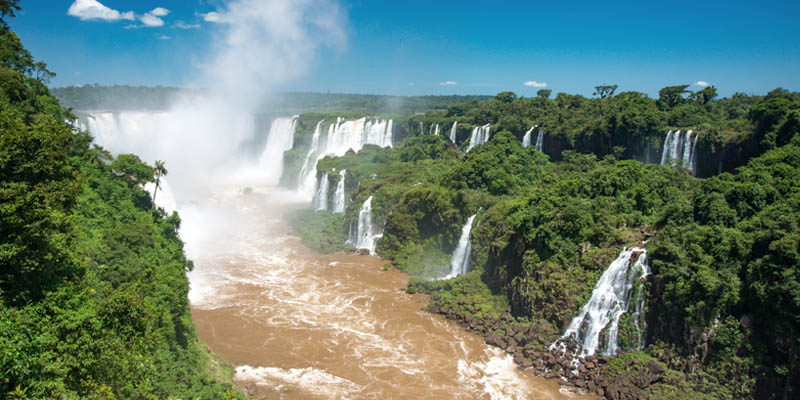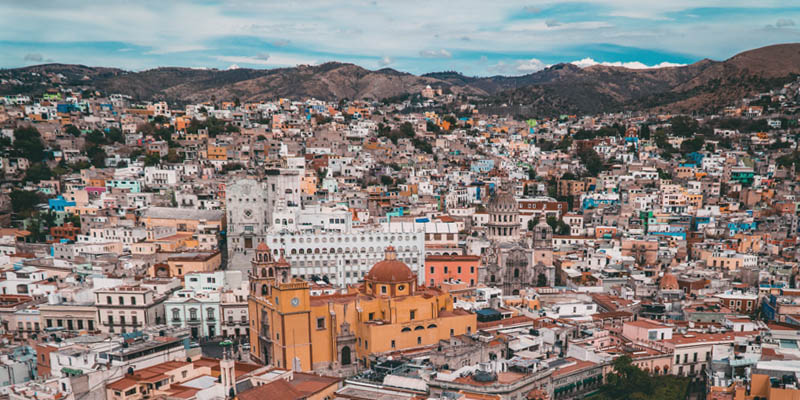We explore Latin America and its culture. In addition, we discuss the economy, religion and history of this region.

What is Latin America?
Latin America is a geographical and cultural region of the Americas, the world's second-largest continent, composed of countries whose official language is derived from Latin (Spanish, Portuguese, and French). It comprises twenty countries, and has a total population of about 650 million.
Most countries in Latin America are Spanish-speaking. Only in one is Portuguese spoken (Brazil), and French (Haiti). The demonym "Latino" is commonly used to refer to people of Hispanic American origin.
All the countries that make up Latin America were conquered in the late 15th century by Spain, Portugal, and France. The European conquest lasted for over three centuries, and it was not until the early 19th century that Latin American countries began the process of political independence. The first among them was Haiti, which became independent from France in 1804.
- See also: North America
Characteristics of Latin America

Among the main characteristics of Latin America are:
- It is made up of 20 countries where Spanish is predominantly spoken, followed by Portuguese and French.
- Its population is composed of a great diversity of races: indigenous natives, mestizos (of indigenous people and European ancestry), and mulattos (of mestizo and African ancestry), among other groups.
- Latin American countries account for 12% of the world's arable land. They are home to one fifth of the world's forests and one third of the world's freshwater reserves.
- Many Latin American countries have significant mineral reserves, including lithium, silver, copper, and tin.
Political geography of Latin America
Latin America is composed of 20 countries:
- In North America. Mexico.
- In Central America. Costa Rica, Cuba, Dominican Republic, El Salvador, Guatemala, Haiti, Honduras, Nicaragua, and Panama.
- In South America. Argentina, Bolivia, Brazil, Chile, Colombia, Ecuador, Paraguay, Peru, Uruguay, and Venezuela.
In addition, Puerto Rico is a free unincorporated territory of the United States. This means that the people of Puerto Rico are United States citizens with rights and responsibilities as such. They can travel freely to the United States, use the US dollar as their currency, and are subject to US regulations and laws.
Puerto Rico is ruled by a governor elected by popular vote. Nevertheless, the United States has authority over matters such as defense, immigration policies, and foreign trade.
All independent countries in the region are full members of the United Nations (UN). In addition, there are regional blocs such as Mercosur (Argentina, Brazil, Uruguay, Paraguay and Venezuela), the Central American Integration System (Costa Rica, El Salvador, Guatemala, Honduras, Nicaragua and Panama), and the Pacific Alliance (Chile, Colombia, Peru and Mexico).
Area and population of Latin America

The countries that make up Latin America cover a total surface area of 7,529,000 square miles (19,500,000 km2), accounting for 13.2% of the planet's total land area.
The population of Latin America is 650 million, which represents 8.1% of the world's total. The population density is 85.4 inhabitants per square mile (33.3 inhabitants per square kilometer). The density is higher in large cities like Lima, Sao Paulo and Mexico City, and is lower in vast, sparsely populated areas such as the Amazon and the Altiplano in Chile, Argentina, and Bolivia.
History of Latin America
Latin America is a region with a rich and varied history spanning over 13,000 years that started with the arrival of the first settlers in the Americas. These early inhabitants settled in various areas, giving rise to distinct cultures and societies.
Among the most prominent pre-Columbian empires in Latin America were the Inca Empire, which flourished for centuries in the Andean region, and the Maya and Aztec Empires in present-day Mexico, Guatemala and Honduras. Other indigenous peoples inhabited several other countries in the region, such as the Aymaras in Bolivia, the Quechuas in Peru, and the Wayuus in Venezuela and Colombia.
The end of the 15th century witnessed the arrival of Spanish and Portuguese colonizers. They established colonies and subjected the indigenous populations to slavery and exploitation in order to extract the region's natural resources.
In the late 18th and early 19th centuries, a process of independence began in most Latin American countries. Under the leadership of figures such as Simón Bolívar, Miguel Hidalgo, José Matías Delgado, and José de San Martín, wars of independence were fought and independence movements were organized, resulting in the liberation of the region from Spanish, French, and Portuguese domination.
During the 20th century, most Latin American countries alternated between dictatorial and democratic regimes for almost 70 years. In recent decades, however, democracy has consolidated as the prevailing political model in most countries in the region.
Culture and religion in Latin America
The most widely spoken languages in Latin America are Spanish and Portuguese. The latter is only spoken in Brazil, but due to its large population, it has nearly the same number of speakers as Spanish, which is the official language in the rest of the countries. French is only spoken in Haiti, with approximately 11 million speakers.
In addition, there are over 300 indigenous languages spoken by millions of people of indigenous descent in several Latin American countries.
Christianity is the predominant religion in Latin America. The majority of the population is Catholic Christian, with a smaller presence of Protestant Christians, especially in Brazil. Other religions in South America include Judaism and Islam.
Additionally, there are Afro-American religions, such as Candomblé in Brazil and Santería in Cuba, which originated with the arrival of African people during the slave trade carried out by European conquerors.
Economy of Latin America
Latin American countries contain a wide variety of natural resources. The vast plains in eastern South America favor agriculture and livestock farming, as well as hydrocarbon extraction. In the mountainous areas, minerals are exploited, and the extensive forested and jungle areas of Brazil and Central America favor the development of forestry activities.
Argentina and Brazil are major soybean producers and exporters. Chile, in turn, is among the leading copper producers and exporters, and Venezuela is a major oil producer and exporter.
The secondary sector is of great importance in the region, especially in Mexico, Brazil, and Argentina. Main industries include automotive, textiles, petrochemicals, and food and beverages. Furthermore, innovation and technology have significantly grown in Latin America, particularly in Brazil.
In addition to trade and services, tourism is a vital activity for many Latin American countries. Caribbean Sea beaches in Mexico, the Dominican Republic and Cuba, ancient Maya cities in Guatemala and Honduras, and Machu Picchu in Peru attract millions of tourists every year.
Countries in Latin America
- Argentina. A Spanish-speaking country due to its past as a Spanish colony until 1816. Located in the southernmost portion of South America, its capital is Buenos Aires. Argentina is divided into 23 provinces, and has a population of over 45 million.
- Bolivia. Situated in the central part of South America, Bolivia has a population of over 11 million. Spanish and other indigenous languages such as Quechua and Aymara are spoken. Its capital is Sucre, though La Paz is the seat of government.
- Brazil. Located in the east of South America, Brazil is the continent's largest country, covering 3.3 million square miles (8.5 million km²). Its capital is Brasília. A Portuguese colony until 1824, Portuguese is the predominant language. Brazil boasts a unique biodiversity and is home to the Amazon River, the longest and one of the largest in the world. It has an estimated population of about 210 million.
- Chile. A Spanish-speaking country (a Spanish colony until 1818) stretching along western South America, Chile is divided into 16 regions. It has a population of over 18 million, and its capital is Santiago de Chile. Chile is characterized by an extensive coastline and the Andes, which traverses its territory north-south and serves as a natural border with Argentina.
- Colombia. A Spanish-speaking country in the northern portion of South America, Colombia has coastlines on the Pacific Ocean and the Caribbean Sea. Its capital city is Bogotá, and it has a population of over 50 million inhabitants. The territory of Colombia is divided into 32 departments. It gained independence from Spain in 1819.
- Costa Rica. A Spanish-speaking country (a Spanish colony until 1821) situated in Central America, Costa Rica has access to both the Pacific Ocean and the Caribbean Sea. It is divided into 7 provinces, which are home to more than 5 million people. Its capital is San José.
- Cuba. An island located in the Caribbean Sea, Cuba’s territory is divided into 15 provinces with over 11 million people. Its capital is the city of Havana, and the official language is Spanish. It gained independence from Spain in 1898.
- Ecuador. Situated in northwestern South America, its capital is Quito. Ecuador’s territory is divided into 24 provinces, and it has a population of 17 million inhabitants. The majority language is Spanish (a Spanish colony until 1820).
- El Salvador. Located in Central America, El Salvador has a coastline on the Pacific Ocean. It is divided into 14 departments and its capital city is San Salvador. It has a population of over 6 million whose official language is Spanish (El Salvador was a Spanish colony until 1821).
- Guatemala. Lying on the northernmost portion of Central America, it is made up of 22 departments, and has over 17 million inhabitants. Its capital is Guatemala City. It was a Spanish colony until 1821, and therefore it has Spanish as the official language.
- Haiti. Located in the Caribbean, Haiti’s capital city is Port-au-Prince. It has a population of over 11 million, distributed among the 10 departments that make up its territory. The official languages are French (Haiti was a French colony until 1804, the year of its independence) and Haitian Creole.
- Honduras. Situated in Central America, Honduras is divided into 18 departments with over 10 million people. Tegucigalpa is the capital and Spanish is the official language, due to its past as a Spanish colony until 1821.
- Mexico. Covering the southernmost area of North America, its capital is Mexico City. Mexico is one of the largest countries by area in Latin America, and has a population of over 127 million. Spanish is the official language, due to its past as a Spanish colony until 1821.
- Nicaragua. Located in Central America, its capital city is Managua. Nicaragua is divided into 15 departments, and its population is estimated at over 6 million. The official language is Spanish due to its past as a Spanish colony until 1821.
- Panama. Situated at the southern tip of Central America, Panama has access to both the Pacific Ocean and the Caribbean Sea. It is divided into 10 provinces and has Panama City as its capital. Panama was a Spanish colony until 1821, hence Spanish is the official language. The country is renowned for the Panama Canal, a monumental engineering work that connects the Pacific Ocean with the Atlantic Ocean. Its population is estimated at 4 million.
- Paraguay. Located in the central area of South America, its capital city is Asunción. Paraguay’s territory is divided into 17 departments, and has a population of approximately 7 million. The official languages are Guarani and Spanish (Paraguay was a Spanish colony until 1811).
- Peru. Situated in western South America, Peru has a population of 32 million. Its territory is divided into 24 departments and its capital city is Lima. Spanish is the official language (it gained independence from Spain in 1821), with Quechua and Aymara also being major languages.
- Dominican Republic. Located in the Caribbean on the island of Hispaniola, the Dominican Republic has a population of 10 million. Its capital city is Santo Domingo. The official language is Spanish, due to its past as a Spanish colony until 1844.
- Uruguay. Lying in southeastern South America, Uruguay’s capital city is Montevideo. It has a population of 3.5 million across the 19 departments that compose the country. The official language is Spanish, having been a Spanish colony until 1825, when it gained its independence.
- Venezuela. Situated in the north of South America, Venezuela’s capital city is Caracas. Its territory is divided into 23 states, with a population estimated at nearly 29 million. The official language is Spanish, having been a Spanish colony until 1842.
References
- FAO (s.f). América Latina y el Caribe. https://www.fao.org/
- Guerra Vilaboy, S. (1997). Etapas y procesos de la historia de América latina. Clacso. http://biblioteca.clacso.edu.ar/
- Prebisch, R. (2012). El desarrollo económico de América latina y algunos de sus principales problemas. CEPAL. https://repositorio.cepal.org/
- Sitio web del Sistema de Integración Centroamericana (SICA). https://www.sica.int/
- Sitio web del Mercosur. www.mercosur.int
- Sitio web de la Alianza del Pacífico. www.alianzapacifico.net
Explore next:
Was this information useful to you?
Yes NoThank you for visiting us :)